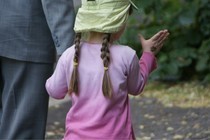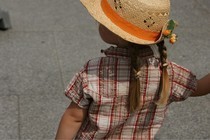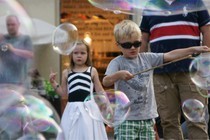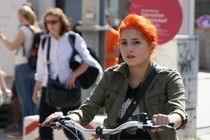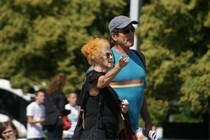Beth Kephart's Blog, page 236
June 22, 2011
Ute Kohnen: The Jeweler of Berlin
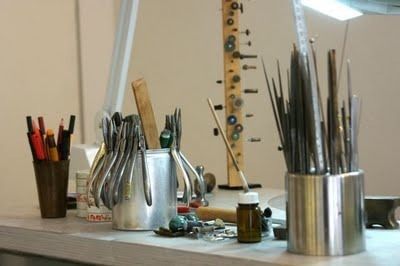
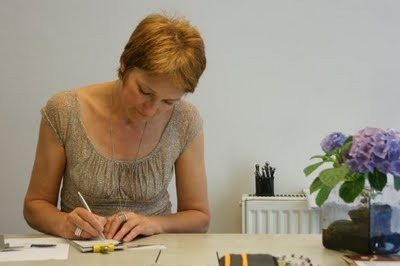
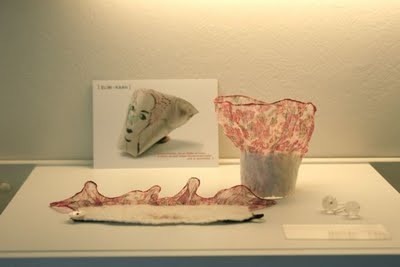 I walked those Berlin streets not in search of beauty (for it was everywhere, breaking through), but in search of a way to intelligently navigate the raw, the refined, and the propulsive.
I walked those Berlin streets not in search of beauty (for it was everywhere, breaking through), but in search of a way to intelligently navigate the raw, the refined, and the propulsive. There in the old Jewish Quarter, not far from the Kunsthaus Tacheles Artist Collective, I found Ute Kohnen. I'd seen her shop a few days before—spare and clean—and when I found my way back to it, the door was open and Ute was inside, repairing a necklace for a customer. I was the only customer there, but Ute let me be, let me study each piece in the Galerie Und Werkstatt—the silver worked by a 21 year old; the fabric bracelets (handmade felt, found buttons, painterly details) of the artist Elim Kaah; the delicate glass bead work and gorgeously original necklaces, earrings, and rings that Ute herself designs and makes.
I asked. Ute indulged me—telling stories about the jewelry itself, about the gallery's history, about Ute's life in Berlin, a city she migrated to directly after the fall of the wall. It isn't easy being an artist, and it's especially difficult in a city like Berlin, where an artist's career is affected as much by tourists' moods and capabilities as it is by rain and sheer luck. But Ute, reaching at times for a translation dictionary, told me stories with a grace that I, a perpetually struggling artist myself, received as something close to holy.
We have to see when we travel. But we also have to listen. I am grateful to Ute, therefore, grateful to this gallery on Linienstrasse 141, for the sanctuary and the conversation. I always buy something lasting in a city I've fallen in love with, and at Ute's shop, I indulged in Elim Kaah's artistry and in one special necklace crafted by Ute herself. The link to Ute's work is here. Images of Elim's remarkable felt artistry can be found here.




Published on June 22, 2011 15:50
The Paris Wife/Paula McClain: Reflections
 Sometimes I read what everyone else is reading. Always, I want to be persuaded. I want to see what it is that propels a big book forward. Get inside it, stand beside it, and marvel.
Sometimes I read what everyone else is reading. Always, I want to be persuaded. I want to see what it is that propels a big book forward. Get inside it, stand beside it, and marvel.The Paris Wife has all the making of a great book. Inspired by the author's read of A Moveable Feast, that great posthumously published Ernest Hemingway remembrance, and populated by the likes of Sherwood Anderson, F. Scott and Zelda Fitzgerald, James Joyce, and Gertrude Stein, The Paris Wife tells the story of Hadley Richardson, Hemingway's first wife—who she is, how she meets Hemingway, and what happens when the two decide to marry. It's familiar terrain, those Paris years—romantic, historic, impossible, made confused and confusing by large amounts of liquor and by allegiances, both professional and personal, that bent in upon themselves. I, like countless others, wrote a research paper on Fitzgerald and Hemingway as a teen. I was obsessed with these authors' books, wanted to pierce the alluring madness, wrote like one and then like the other, never gave up my Gatsby habit, cry every time I read The Old Man and the Sea. I was obsessed with Zelda and I have, at various times in my life, given myself over to Joyce, then over to Pound, then over to those parts of Gertrude that I have the brain cells to understand.
This is a book I should have loved.
I wanted, however, more than was here. Less explication, perhaps, more alivedness on the page. Less chunking in of familiar history and more of that exquisite and also inexplicable thing that happens, say, in Monique Truong's The Book of Salt, which steals inside the Gertrude Stein/Alice B. Toklas household by way of a Vietnamese cook. Truong, with her novel, dares to imagine, dares to create a whole and surprising story that illuminates the past but is not so strictly beholden to it. She reminds us that novels, in the end, are novels, not biographies, and so there is room to do far more than to place small wagers on undocumented in-bewteens.
In the case of The Paris Wife, we know, from the outset, what happens to Hadley (if not from our own reading, then from the author's opening pages). It is imperative, then, that Hadley's inner life soar, that McClain go deep, that she surprise us, get to us, with the unanticipated detail, the original slice of talk, the something in the shadows, the something in the light. I kept looking for that, hoping for it, for this is such an admirable project and McClain herself is so entirely likable in the interviews I've heard and read.
But what, really, do I know? The Paris Wife, like Nancy Horan's famous spurned wife story, Loving Frank, is a huge bestseller, much beloved by a vociferous crowd. I have stood in the margins most of my life, and I recognize, always, that I look for other things in books than many do. Might I suggest that there is room for us all.[image error]




Published on June 22, 2011 13:25
Self-portrait in Berlin
 At the Berlin Zoo, Germany's first zoo and Europe's most visited zoological attraction.[image error]
At the Berlin Zoo, Germany's first zoo and Europe's most visited zoological attraction.[image error]



Published on June 22, 2011 04:32
Desperate Characters/Paula Fox: Reflections
[image error]
I read four books while I was away (beyond all that I read about Berlin). I reported on the first—If I Loved You, I Would Tell You This, Robin Black's debut short story collection—here. I'll be reporting on the others (The Paris Wife, The Coffins of Little Hope) in days to come.
But this very early morning, I'm reflecting on the scouring brilliance of Paula Fox's Desperate Characters. It's a book I'd always meant to read, an author whose story I have followed. That doesn't mean that I was prepared for the hard, bright smack of Fox's sentences, the relentless disintegration of a domestic arrangement that may or may not hold. We have Jonathan Franzen to thank for helping to bring Desperate Characters back into print and wide circulation. We have, in the Norton edition, his essay that suggests that the book is, "on a first reading," "a novel of suspense."
As the novel opens, Sophie Brentwood is bitten by a stray cat; Sophie's hand swells. Sophie should have the hand checked, but she is afraid. She can imagine dire consequences—rabies, even death—but other underlying fears persist and complicate. Three days will go by, and the wound will keep molting, oozing, disfiguring, haunting, and this is the running tension—this cat bite, this not knowing, this unwillingness to find out, this false hope that comforts lie elsewhere (in drink, in friendship, in secrets, in lashing out). Into this strange, unsettling frame Fox inserts the fractures of a marriage in naked near stasis. Sophie and her husband, Otto, are childless. Otto is abandoning a business partnership with a long-time friend, Charlie—bating him, hating him, feeling abandoned and abused by him. Brooklyn, finally, is scathing and scabrous and ill-equipped, in these late 1960s, to wrap this couple in a numbing sheen.
Sophie and Otto know too much. They see too much. They both despise excessively and love forlornly. Is this all that marriage is? All it offers? Is there refuge among the refuse? In whose arms can one trustingly take shelter? Desperate Characters is a brutal book, a lacerating book, and if that makes it a hard book to read, it also makes it an impossible book to put down. I, for one, read the bulk of it while being jostled about during a long wait at the Berlin airport.
There are easy books, and there are hard books, and I will be honest: I prefer the latter. I want to be tested. I want to think. I want to study a book and ask, in awe, How in the world was this made? Desperate Characters has me asking.[image error]




I read four books while I was away (beyond all that I read about Berlin). I reported on the first—If I Loved You, I Would Tell You This, Robin Black's debut short story collection—here. I'll be reporting on the others (The Paris Wife, The Coffins of Little Hope) in days to come.
But this very early morning, I'm reflecting on the scouring brilliance of Paula Fox's Desperate Characters. It's a book I'd always meant to read, an author whose story I have followed. That doesn't mean that I was prepared for the hard, bright smack of Fox's sentences, the relentless disintegration of a domestic arrangement that may or may not hold. We have Jonathan Franzen to thank for helping to bring Desperate Characters back into print and wide circulation. We have, in the Norton edition, his essay that suggests that the book is, "on a first reading," "a novel of suspense."
As the novel opens, Sophie Brentwood is bitten by a stray cat; Sophie's hand swells. Sophie should have the hand checked, but she is afraid. She can imagine dire consequences—rabies, even death—but other underlying fears persist and complicate. Three days will go by, and the wound will keep molting, oozing, disfiguring, haunting, and this is the running tension—this cat bite, this not knowing, this unwillingness to find out, this false hope that comforts lie elsewhere (in drink, in friendship, in secrets, in lashing out). Into this strange, unsettling frame Fox inserts the fractures of a marriage in naked near stasis. Sophie and her husband, Otto, are childless. Otto is abandoning a business partnership with a long-time friend, Charlie—bating him, hating him, feeling abandoned and abused by him. Brooklyn, finally, is scathing and scabrous and ill-equipped, in these late 1960s, to wrap this couple in a numbing sheen.
Sophie and Otto know too much. They see too much. They both despise excessively and love forlornly. Is this all that marriage is? All it offers? Is there refuge among the refuse? In whose arms can one trustingly take shelter? Desperate Characters is a brutal book, a lacerating book, and if that makes it a hard book to read, it also makes it an impossible book to put down. I, for one, read the bulk of it while being jostled about during a long wait at the Berlin airport.
There are easy books, and there are hard books, and I will be honest: I prefer the latter. I want to be tested. I want to think. I want to study a book and ask, in awe, How in the world was this made? Desperate Characters has me asking.[image error]




Published on June 22, 2011 02:47
June 21, 2011
Piccadilly, Buckingham Palace, and the Dancing Musicians of Covent Gardens: 45 seconds, stolen
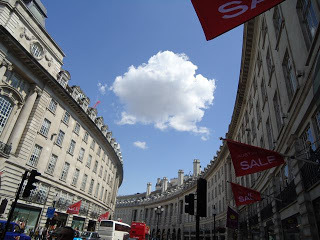

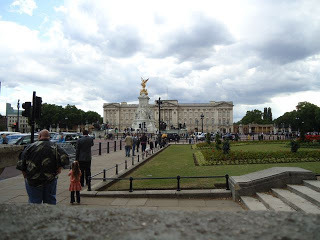
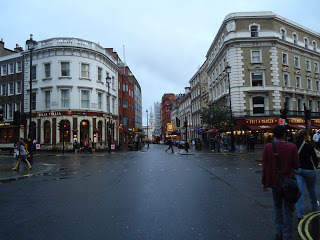

London bracketed our trip to Berlin, but my experience of the city was fleeting. Mostly we were there to see our magnificent son, now studying abroad. We walked, we sat, we ate, we walked some more. Past Buckingham, into Westminster, through Piccadilly at night, just after rain. We had our one extravagant, truly delicious meal at Gaucho, thanks to the spot-on recommendation of a friend. We were driven across the Tower Bridge shortly after one a.m., a moment I don't imagine I'll forget.
In the midst of it all, we wandered through Covent Gardens, in London's west end, and I snatched this interlude just because. Have you ever seen a violinist dance, with the violin in hand? Watch for a few moments, and you will.




Published on June 21, 2011 17:48
June 19, 2011
Going Home: Ein Konzert fur die Berliner Domstiftung
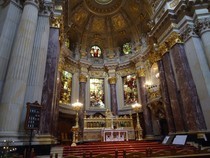
We spent the final evening not as tourists but as audience within the Berliner Dom. The thirty members of the Berliner Domkantorei gathered, to begin, at the back of this cathedral, lifting their voices up, then moved progressively and finally en masse toward the altar. The Berliner Domblaser, a brass ensemble, answered their song. The organ responded. It was eight in the evening, and we were far from that crowd, beneath that magnificent dome, unbothered by the worldly silences or professional frustrations we did manage to leave entirely at home.
Nothing bothered me here. All was new, an invitation. I leave Berlin with a fuller understanding of a devastating regime, a great respect for a city's ability and willingness to rebuild, a broader alignment with architecture both restorative and radical, and a love for the gentle grunge and craftsmanship of a proliferated artist community.
The skies, by the way, are exactly as Chloe Aridjis describes in her evocative and powerful slender novel, The Book of Clouds, which led me, like the great historian and writer Paul Steege led me, like my friend Tamra led me, to this city.
It had been a long time since I traveled like this. I am different than I was, and different than I will no doubt now be.
Thanks for journeying with me.
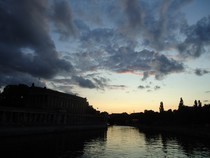




Published on June 19, 2011 01:40
June 18, 2011
It is always, in the end, at the end, the children
Published on June 18, 2011 00:44
June 17, 2011
The red headed tourists (and me)
Published on June 17, 2011 08:09
The red headed tourists and I
Published on June 17, 2011 08:09
June 16, 2011
The biggest bubble in the...world?
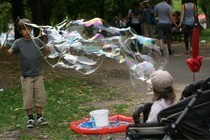
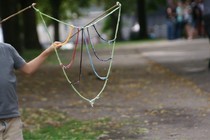
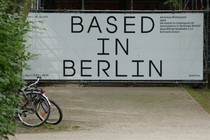
When we were younger, my mathematically minded brother was at times focused on the art of bubble making. He had a knack for the thing, could turn a dash of Ivory soap into an effervescence. Bubble art mattered. So did bubble largesse.
He--you, dear brother--may have met your competition. I present this young man to you now--his process and his product--because I am just that kind of sister, and because this is just that kind of blog--literary, erudite, and highly informative about the most important things.




Published on June 16, 2011 10:48

